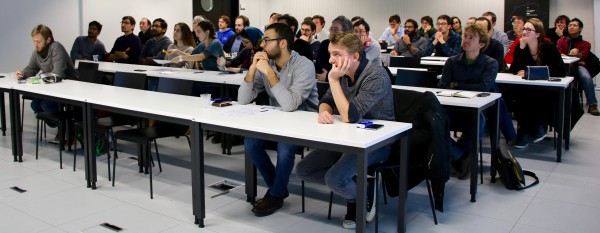MARVEL Junior Seminar — April 2023

Each seminar consists of two presentations of 25 minutes each, allowing to present on a scientific question in depth, followed by time for discussion. The discussion is facilitated and timed by the chair.
Onsite participation
11:45 — Pizzas will be served in the MED building atrium, second floor
12:15 — Seminars take place in EPFL room Coviz2 (MED 2 1124)
Online participation
Starting at 12:15:
https://epfl.zoom.us/j/68368776745
Password: 1923

Talk 1 — Opto-electronic properties of barium titanate from first principles
Virginie de Mestral
Integrated Systems Laboratory, ETHZ
Linear electro-optical modulators based on barium titanate (BTO) integrated onto a silicon photonics chip can greatly improve the bandwidth of telecommunication devices and help reduce their power consumption. The underlying physics relies on the so-called Pockels effect, where the optical refractive index of a material can be modulated by an applied electric field.
In order to fabricate high-performance BTO modulators, a precise understanding of the Pockels effect and of its dependence on crystal defects is required. For this, we developed a framework to calculate the electronic and vibrational contributions to the Pockels tensor from first-principles using DFT, the Berry-phase formalism, and a finite-difference approach. Additionally, anharmonic dynamic instabilities of the BTO structure at room temperature are stabilised thanks to a supercell construction, where atomic degrees of freedom are enabled along the atomic displacements directions of the lower-temperature stable phase.
We show that the r13, r23 and r33 elements of the tetragonal BTO Pockels tensor can be accurately calculated within the Born-Oppenheimer approximation, as they exclusively depend on the electronic response to an external electric field. In contrast, the r42 and r51 tensor elements are subjected to strong vibrational contributions via the change in Raman polarizability, optical phonon modes polarities and frequencies. Since the tetragonal phase of BTO, which is stable within the range of 300K to 400K, is of high practical relevance, AIMD calculations must be introduced into our framework to correct for the
effects of finite temperature.
Talk 2 — Total energies from the Klein and the Luttinger-Ward energy functionals: benchmarking conserving many-body approximations
Giovanna Lani
Laboratory of Theory and Simulation of Materials (THEOS), EPFL
In this work we investigate the performance of two well-known many-body energy functionals, derived respectively by Klein and Luttinger and Ward, at different levels of diagrammatic approximations, ranging from second Born, to GW, to the so-called T-matrix, for the calculation of total energies and spectral functions.
We benchmark our theoretical results on the extended two-site Hubbard model, which is analytically solvable and for which several exact properties can be calculated. Despite its simplicity, this model displays interesting physics: it is prototypical of the H2 dissociation, a notoriously difficult problem to solve accurately for the majority of mean-field based approaches.
We show that both functionals exhibit good to excellent variational properties, particularly in the case of the Luttinger-Ward one, and elucidate the relation between the accuracy of the results and the different input one-body Green's functions
Provided that such input is wisely chosen, we demonstrate how the Luttinger-Ward functional can be used as a computationally cheaper alternative to fully self-consistent many-body calculations, without sacrificing the precision of the results obtained.
Furthermore, in virtue of this accuracy, we argue that this functional can also be used to rank different many-body approximations at different regimes of electronic correlation, once again bypassing the need for self-consistency.
Check the list of the next MARVEL Junior Seminars here.
Low-volume newsletters, targeted to the scientific and industrial communities.
Subscribe to our newsletter